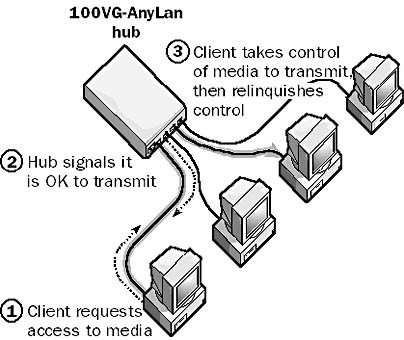Demand Priority is a media access control method for 100VG-AnyLan networks.
What is Demand Priority?
A media access control method for 100VG-AnyLan networks. 100VG-AnyLan is a high-speed form of Ethernet based on the IEEE standard 802.12 developed by Hewlett Packard.
Demand priority is the method by which stations on a 100VG-AnyLan network gain access to the wire for transmitting data.
How it works
A 100VG-AnyLan network based on the demand priority access method consists of end nodes (stations), repeaters (hubs), switches, routers, bridges, and other networking devices. A typical 100VG-AnyLan network consists of a number of stations plugged into a cascading star topology of repeaters (hubs). Because of timing, a maximum of five levels of cascading of the physical wiring is permitted. Hubs are connected using uplink ports. Each hub is aware only of the stations directly connected to it and any hubs that are uplinked from it.
The key feature of the demand priority access method, as shown on the illustration, is that the 100VG-AnyLan hubs control which computers are allowed to transmit signals on the network at any given moment.
Hubs can be thought of as servers and end nodes as computers (clients). With demand priority, a client (a computer with a 100VG-AnyLan network interface card installed in it) must first request access to the network media (cabling) before transmitting data. The server (hub) processes this request and decides whether to allow the client access to the media. If the hub decides to grant the client access to the wire, it sends the client a signal informing it of this decision. The client then takes over control of the media and transmits its data.

Demand priority is considered a contention method, but it operates differently from the Carrier Sense Multiple Access with Collision Detection (CSMA/CD) access method used in Ethernet networks.
Cables in a 100VG-AnyLan network are capable of transmitting and receiving data at the same time using all four pairs of twisted-pair cabling in a quartet signaling method.
Each pair of wires in a twisted-pair cable transmits and receives data at 25 MHz, for a total bandwidth of 100 MHz. All contention on the network occurs at the hub. If two computers attempt to transmit signals at the same time, the hubs can either choose between the two signals based on priority or alternate between them if the priorities are equal.
The hubs can do this because demand priority provides mechanisms for prioritizing transmission of different data types. Computers in demand priority networks can simultaneously transmit and receive data, and they do not need to listen to the network because the hubs control access to the wire.